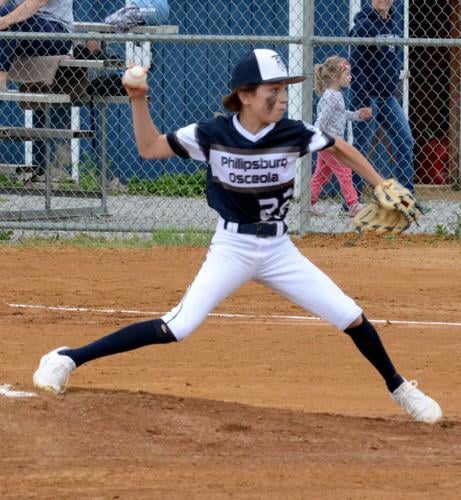A Putout, abbreviated as PO, is a key baseball statistic. It refers to an action that records an out.
In baseball, understanding the term “PO” is crucial for both players and fans. A Putout can happen in various ways, such as catching a fly ball or tagging a runner. This statistic helps in measuring a player’s defensive skills. It’s a term often seen on scorecards but might be confusing for newcomers.
This introduction will clarify what a PO is and its importance in the game. Whether you’re a budding player or a curious fan, knowing about POs will deepen your appreciation for baseball. Let’s dive into the details of what makes a PO significant.

Credit: www.youtube.com
Introduction To Putouts
Baseball is rich with its own set of terms and rules. One such important term is “Putout,” often abbreviated as “Po.” Knowing about Putouts is essential for understanding defensive play. This section will dive into the basics of Putouts in baseball.
Definition Of Putouts
A Putout happens when a defensive player records an out. This can occur in various ways. For instance, catching a fly ball, tagging a runner, or stepping on a base for a force out. Each of these actions results in a Putout. The player involved gets credited with a Po in the scorebook. Understanding Putouts helps in appreciating the skills of defensive players.
Importance Of Putouts In Baseball
Putouts play a crucial role in the game. They are key in preventing the opposing team from scoring. Every Putout brings the defensive team closer to ending an inning. Good defensive teams excel at making Putouts efficiently. This often leads to fewer runs allowed. Putouts also highlight individual player skills. Players with high Putout counts are often seen as valuable defenders. Their ability to secure outs can change the course of a game.
Roles In Putouts
In baseball, a putout (PO) is a statistic that records the defensive player responsible for completing a play that results in an out. This can involve various players on the field, each with specific roles and responsibilities. Let’s explore these roles to better understand how putouts work.
Fielders’ Responsibilities
Fielders play a crucial role in achieving putouts. Each fielder has a unique position and set of duties:
- First Baseman: Often involved in catching throws to first base to get the batter out.
- Second Baseman: Covers second base and fields ground balls.
- Shortstop: Fields ground balls and often makes long throws to first base.
- Third Baseman: Handles bunts and fields ground balls near third base.
- Outfielders: Catch fly balls and make crucial throws to infielders.
Pitchers’ Involvement
Pitchers also contribute to putouts, though their role differs from fielders:
- Strikeouts: When a pitcher throws three strikes, the batter is out, earning the pitcher a PO.
- Fielding: Pitchers may field ground balls and make throws to first base.
- Covers Bases: In some plays, pitchers cover first base when the first baseman fields a ball.
Understanding these roles helps appreciate the teamwork involved in baseball. Each player, from fielders to pitchers, contributes to the game’s defense, ensuring outs are made efficiently.
Types Of Putouts
In baseball, a putout (Po) is a crucial statistic that records the act of a defensive player retiring a batter or baserunner. There are different types of putouts that can occur during a game. Understanding these types can help appreciate the strategic aspects of baseball.
Force Outs
A force out happens when a runner is compelled to advance to the next base because the batter becomes a runner. The defensive player only needs to touch the base the runner is advancing to, holding the ball. This type of putout is common and can be seen often in double plays.
Tag Outs
A tag out occurs when a fielder touches a baserunner with the ball or with a glove holding the ball. The runner must be off the base for the tag out to be valid. This requires precise timing and coordination between the fielders.
Common Putout Scenarios
Understanding common putout scenarios in baseball helps fans and players alike. Knowing these situations can enhance your appreciation of the game. Let’s dive into some typical scenarios where putouts occur.
Fly Balls
A fly ball is a hit that goes high into the air. Outfielders and infielders catch these balls for a putout. If an outfielder catches a fly ball, it’s called a catch. This is one of the most common putout scenarios in baseball.
Key points about fly balls:
- Outfielders must track and catch the ball.
- Infielders can also catch fly balls.
- Fly balls can be caught in foul or fair territory.
- The batter is out if the ball is caught before it hits the ground.
Ground Balls
A ground ball is a hit that stays low and rolls or bounces on the ground. Infielders play a crucial role in fielding ground balls. They must field the ball cleanly and throw it to the correct base for a putout.
Common ground ball putout scenarios:
- First Base: The infielder fields the ground ball and throws it to the first baseman. The first baseman catches the throw before the batter reaches the base.
- Force Out: The infielder throws the ball to a base where a runner must advance. This can happen at second, third, or home plate.
- Tag Out: The infielder fields the ball and tags a runner attempting to advance. This requires quick reflexes and precise timing.
Each ground ball scenario involves quick thinking and coordination. Infielders must communicate and react swiftly to ensure a successful putout.
Putouts By Position
Understanding putouts in baseball is essential for any fan or player. Different positions on the field contribute to putouts in unique ways. This section breaks down putouts by position, focusing on both the infield and the outfield.
Infield Putouts
Infielders often make putouts during ground balls or force plays. Here are some common putouts by infield position:
- First Baseman (1B): Often receives throws from other infielders to complete putouts. They also make unassisted putouts by fielding grounders or catching line drives.
- Second Baseman (2B): Typically involved in double plays. They receive throws and tag runners or step on the base.
- Shortstop (SS): Similar to the second baseman, they often make putouts on force plays and double plays.
- Third Baseman (3B): Usually makes putouts by fielding ground balls and throwing to first. They also catch pop flies in foul territory.
- : Records putouts by catching strikeouts, tagging runners, and fielding bunts.
Outfield Putouts
Outfielders primarily make putouts by catching fly balls. Here is a breakdown of outfield putouts by position:
- Left Fielder (LF): Makes putouts by catching fly balls and line drives hit to left field.
- Center Fielder (CF): Often covers the most ground. They catch fly balls and line drives hit deep into the outfield.
- Right Fielder (RF): Similar to the left fielder, they catch fly balls and line drives hit to right field.
Below is a table summarizing putouts by position:
| Position | Common Putouts |
|---|---|
| First Baseman (1B) | Receives throws, unassisted grounders, line drives |
| Second Baseman (2B) | Double plays, force plays |
| Shortstop (SS) | Force plays, double plays |
| Third Baseman (3B) | Fielding grounders, pop flies |
| Catcher (C) | Strikeouts, tagging runners, fielding bunts |
| Left Fielder (LF) | Catching fly balls, line drives |
| Center Fielder (CF) | Catching fly balls, line drives |
| Right Fielder (RF) | Catching fly balls, line drives |
Statistical Significance
Statistical significance measures the likelihood that a result is not due to chance. A “Po” in baseball stands for “putout,” which occurs when a fielder directly retires a batter or runner.
Understanding statistical significance in baseball can help fans appreciate the game more. Players’ stats show their performance. One key stat is the Putout (PO).
Putouts In Player Statistics
Putouts are crucial in player stats. They show a player’s defensive skill. A putout happens when a player catches a fly ball. It also occurs when they tag a runner out. First basemen often have high putout numbers. They catch throws from other infielders to get batters out.
Impact On Team Performance
Putouts affect team performance greatly. Teams with more putouts have strong defense. This reduces the opponents’ chances to score. Good defensive players contribute to team success. They help win games by preventing runs. So, putouts are key for a winning team.
Historical Putout Records
Baseball history is rich with outstanding putout records. These records highlight the defensive skills of players. A putout, often abbreviated as PO, is a crucial part of the game. It occurs when a defensive player successfully outs a runner. Below, we explore some of the most notable records.
Notable Players
Many players have made their mark in baseball with high PO records. Some of the most notable players include:
- Jake Beckley: Holds the record for most putouts by a first baseman.
- Frank Chance: Known for his remarkable putout statistics.
- Ed Konetchy: A significant player in the putout records history.
Record-breaking Moments
Several moments in baseball history stand out for record-breaking putouts. These moments showcase the defensive prowess of players.
| Player | Record | Date |
|---|---|---|
| Jake Beckley | 23,767 putouts | Early 1900s |
| Frank Chance | 21,011 putouts | 1900-1910 |
| Ed Konetchy | 21,361 putouts | 1910-1920 |
These records reflect the hard work and dedication of these players. They set a high standard for defensive play in baseball.

Credit: www.theprogressnews.com
Training For Effective Putouts
In baseball, a putout (PO) is a crucial defensive play. To be effective, players must train consistently. Training involves specific drills and exercises. It also includes improving reaction time. These practices help players make quick and accurate plays. Let’s delve into some effective methods.
Drills And Exercises
Consistent practice of drills and exercises improves putout skills. Below are some key drills:
- Fielding Ground Balls: Players practice fielding ground balls from various angles. This helps build agility and coordination.
- Tagging Runners: Set up scenarios where players practice tagging out runners. This enhances their quick decision-making skills.
- Throwing Accuracy: Players work on throwing to bases accurately. This drill is essential for reducing errors.
Incorporating these drills into daily routines boosts overall defensive performance.
Improving Reaction Time
Reaction time is vital for successful putouts. Faster reactions lead to more effective plays. Here are some exercises to improve reaction time:
- Reaction Ball Drills: Use a reaction ball that bounces unpredictably. This helps players react quickly to unexpected movements.
- Quick Hands Drills: Practice catching and throwing rapidly. This increases hand-eye coordination and speed.
- Agility Ladder Drills: Use an agility ladder to improve foot speed. This helps players move swiftly to make plays.
Regularly practicing these exercises enhances a player’s ability to react swiftly and efficiently.
Frequently Asked Questions
What Does Po Mean In Baseball?
Po in baseball stands for Putout. It refers to a defensive player recording an out.
How Is A Po Recorded?
A Po is recorded when a defensive player catches a fly ball, tags a runner, or steps on a base for a force out.
Who Gets Credited With A Po?
The player who directly makes the out gets credited with a Po. This is usually a fielder.
Why Is A Po Important In Baseball?
A Po is crucial because it signifies a defensive player successfully recording an out, preventing the opposing team from scoring.
Conclusion
Understanding a PO in baseball is now easier. This term highlights defensive skills. Players earn POs by catching balls, tagging bases, or runners. It’s a key stat. It helps in evaluating fielders. Knowing this enhances your baseball knowledge. Next game, watch for POs.
It will deepen your appreciation. Baseball is more than just hitting. Defense matters too. Enjoy the game with this new insight.





